MiniRobotLanguage (MRL)
LVI. Command
ListView32 Command
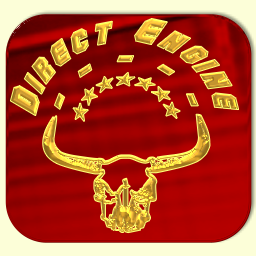
Intention
These command will select a Listview item. A Listview is a special type of control and may look like this (Listview in Report-Mode):
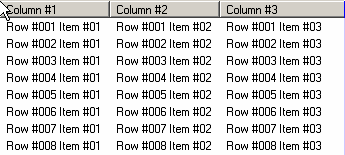
Listviews that are not in Report-Mode may show Icons for the elements they contain:
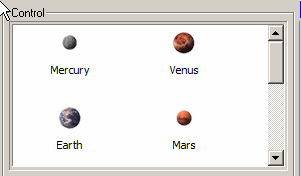
The desktop is also a Listview Control, and it shows Icons.
Therefore the LVI.-Command can also be applied on the Windows Desktop.
Using LVI. you can locate Items in a Listview by their numeric position, or using a textual description. If you use a textual description, 3.2 Standard-Search Pattern can be used.
Depending on the SubCommand, LVI. has multiple purposes.
Syntax
LVI.P1[.OPT][...|Px]
The Syntax depends on the used Subcommands:
Parameter Explanation
P1 - Subcommand, is one of the following Subcommands:
Find a Listview Item by name, locate center of text area (and navigate)
"ftbn","find text by name"
This Subcommand finds a Listview Item using a Substring of the Text that it contains.
3.2 Standard-Search Pattern can be used.
The item will be located, you will find Information about the item on the TOS.
' Using this example, the TOS looksl ike this:
LVI.ftbn.unc|thre
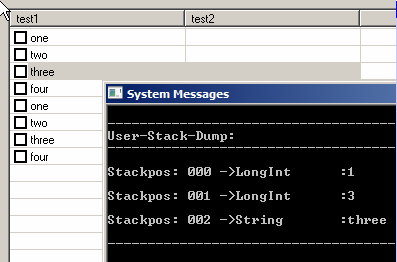
LVI.ftbn|P2|P3|P4|P5
P2 - Text textual Pattern you want to search for
P3 - (optional) Number of occurrence
P4 - (optional) Navigate X by Steps
P5 - (optional) Navigate Y by Steps
using P4 and P5, you can find a specified Item and then navigate from there in X-
or Y-direction to another item.
Examples:
LVI.ftbn|Earth
LVI.ftbn|Ear&OR:Mar
LVI.ftbn.mlm|Earth
LVI.ftbn|Earth||1
Find a Listview Item by name, locate Icon area (and navigate)
"fibn","find icon by name"
This Subcommand finds a Listview Item using a Substring of the Text that it contains.
It will locate the Icon Area to the left instead of the Text-Area.
3.2 Standard-Search Pattern can be used.
The item will be located, you will find Information about the item on the TOS.
LVI.fibn|P2|P3|P4|P5
P2 - Text textual Pattern you want to search for
P3 - (optional) Number of occurrence
P4 - (optional) Navigate X by Steps
P5 - (optional) Navigate Y by Steps
using P4 and P5, you can find a specified Item and then navigate from there in X-
or Y-direction to another item.
Examples:
LVI.fibn|Earth
LVI.fibn|Ear&OR:Mar
LVI.fibn.mlm|Earth
LVI.fibn.chk|Earth
LVI.fibn|Earth||1
Find a Listview Item by number
"fbn","find by number"
This Subcommand finds a Listview Item using numerical coordinates.
You can specify an X- (Row) and an Y- (Column).
Both numbers are 1-based.
The item will be located, you will find Information about the item on the TOS.
000 Column-Number or zero
001 Row-Number, 1- based
002 Name if item that was found
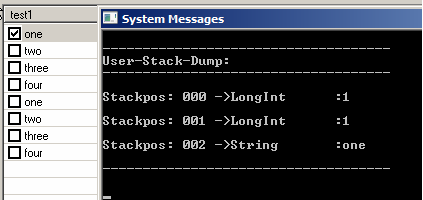
Examples:
' Locate 4'th item in a single column LV
LVI.fbn|4
' Locate 4'th item in the second row of a multi-column LV
LVI.fbn|4|2
' Locate the first item and check the checkmark
LVI.fbn.chk|1
Get number of Items, number of columns, Listview-Style number and Unicode
Information
"gin","get info"
This Subcommand will retrieve needed informations about the Listview. You can omit
parameters that you do not need. In that case these values are placed on the TOS.
LVI.get info|P2|P3|$$STL|$$UNI
The first Variable P2 receives the number of Lines thats in the Listview (Line-Count).
Variable P3 receives the number of Columns if the Listview has more then one.
Variable P4 receives the Listview Style value. This is for advanced use only.
Variable P5 receives 0 or 1 if the Listview is a Unicode Control (1) or an ANSI Control (0).
There is a Unicode conversion built in. Some Listviews are marked as Unicode and are
not used as such, in this case you may get "??????" as textual result.
You can then use the "Force Unicode" Subcommand to set this Flag to 0 and make the
Control readable.
LVI.get info|$$TAY|$$TAX|$$STL|$$UNI
Set the text of the selected item to another text / change text
"sit","set item text"
You can change the text of an item using this command.
LVI.sit|TY|TX|Text
Unselect all Items in the Listview
"usa","unselect all items"
This will unselect all selected items in the Listview.
Depending on the Listview, some Listviews may not support this command.
Select all Items in the Listview
"sai","select all items"
This will select all items in the Listview.
Depending on the Listview, some Listviews may not support this command.
Cancel Edit Mode
"nedi","cancel edit label"
Set the Unicode Flag of the Listview
"funi","force unicode"
You can set the unicode flag of the Listview to 0 or to 1.
This will influence the way that the text is internally interpreted, at least under x32.
Sometimes Controls are marked as Unicode but are not used as that.
In that case you may receive textual results like ?????? ??? and nothing is found.
If so, set the unicode flag to zero using this command before using other LVI. commands.
Fake Unicode processing
"fauni","fake unicode"
This will influence the way that the text is internally interpreted, at least under x32.
It will not physically change the Unicode flag inside the Control.
It will only change the way, all further LVI.-Commands process the Text.
This currently has only an effect under x32 Applications.
.OPT - You can add one or more of these Options to any of the Subcommands.
Then the selected Options will be used on the Target-Listview-Item.
Possible Options are:
.lbo - Move Actual Point to Left Border for all later commands
.rbo - Move Actual Point to Right Border for all later commands
.foc - focus item
.sel - select item
.chk - check a checkamrk on that item
.unc - uncheck a checkamrk on that item
.vse - Enshure visible + select Item
.usa - unselect all items
.ndi - cancel Item-Text editing
.edi - Start Item-Text Editing
.upd - Update/Redraw Listview Control
.uns - unselect this item
.del - delete Item from Listview
.wii - Wait for Input Idle
The following Options are not available as .OPT under x64.
Just use the normal SPR Commands (MLE.,MLM. etc. instead).
Also note that these clicks always hit the item-Center, even if you have specified .lbo or .rbo.
.mle - Direct Engine Click
.mli - do a compatible Click
.mdc - do a Double Click
.mlm - do a MLM-Click
.clr - do not do any selection, this will clear all other .OPT Flags
Example
'***********************************************
' LVI.-Sample
'***********************************************
' If no such item as specified is found,
' the timeout-flag is neen set.
' You can check that using the ITO-Query.
'
STW.ct|#32770|item
SCW.nc|1|SysListView32
LVI.ftbn.unc|threx
ITO.
MBX.No such item was found
EIF.
MMV.
STS.DUMP
MBX.!
ENR.
'***********************************************
Remarks
On the stack, you can find the name of the selected element.
This useful, if it was selected using a Pattern.
The command has internally a different path for x32 and x64 applications.
Some features may not do exactly the same under x64 and x32.
Also some features may not work under both types of OS.
Limitations:
Some features may not work under x64, in th3e same way as they do under x32.
See also: